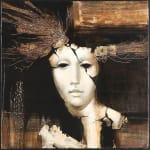
 Frame
Frame
Jacopo SCASSELLATI
16 x 16 in
In Mater, Jacopo Scassellati presents one of his most emblematic meditations on creation, fragility, and spiritual endurance. The work, executed in 2014, stands at a turning point in his development — when his early fascination with classical form began to merge with a deeper metaphysical language rooted in fragmentation and rebirth.
At the center of the composition, a female mask-like face emerges from a dark, indeterminate ground. It is both sculptural and spectral, its smooth ivory surface intersected by delicate cracks and fissures, as if unearthed from time. The expression is calm, detached, and yet profoundly human — a paradox that anchors the painting between icon and ruin.
The title, Mater (“Mother”), infuses the image with sacred resonance. The fissured visage becomes not a symbol of decay but of origin — the vessel through which existence itself manifests. The fractures, meticulously painted with linear precision, do not wound the face; they animate it, turning matter into a map of creation. In Scassellati’s cosmology, breaking is not destruction but transformation: the visible mark of life’s unfolding.
Emerging from the upper edge of the head, two delicate organic forms — resembling branches or veins of light — extend laterally, suggesting cerebral growth or divine emanation. They bridge the boundaries between the human and the vegetal, echoing Renaissance metaphors of the anima mundi — the world soul that animates all things. These filaments, rendered in fine metallic pigment, pulse like currents of thought or energy, linking the sacred interior of the figure with the infinite beyond.
Chromatically, the painting oscillates between earth and light — ochres, siennas, and umbers layered with whites and pale gold. This restricted palette heightens the sense of timelessness, recalling aged frescoes and devotional panels. Scassellati’s brushwork alternates between smooth sfumato and rough texture, creating a dual sensation of the eternal and the eroded.
Formally, Mater can be read as an homage to the archetype of the Madonna — stripped of narrative, reinterpreted as a universal matrix. The absence of overt religious iconography allows the figure to transcend dogma, becoming an emblem of the creative feminine principle, the prima materia from which both art and life emerge.
In art-historical terms, Scassellati situates himself within a lineage that includes Leonardo’s introspective portraits, Giorgio de Chirico’s metaphysical stillness, and the Symbolists’ psychological intensity. Yet his approach is uniquely contemporary: he reinvents the sacred image through the language of fracture and restoration, balancing destruction and renewal as inseparable forces.
Mater is thus a meditation on memory as material, on the persistence of beauty through imperfection. The serene face, split yet whole, reminds us that every act of creation carries within it the memory of breaking — and that through these fractures, light finds its way back to the surface.


